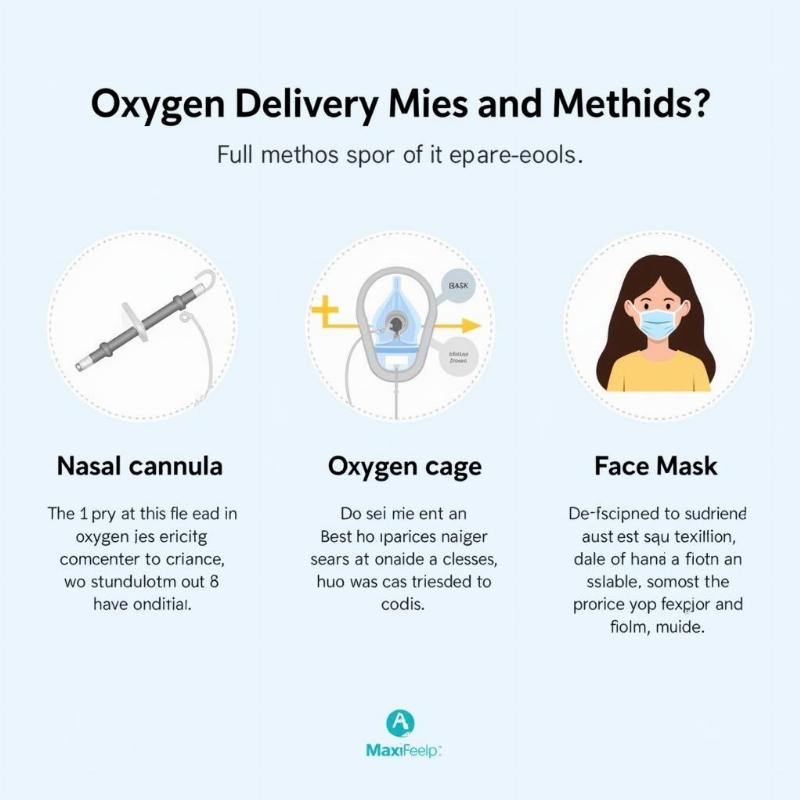Oxygen therapy can be a lifeline for dogs struggling with respiratory issues. Understanding how to administer this therapy at home can significantly improve your dog’s comfort and well-being. This article provides a comprehensive guide for pet owners in the US on administering oxygen therapy for dogs at home, covering everything from recognizing the signs of respiratory distress to setting up and maintaining oxygen equipment.
Recognizing When Your Dog Needs Oxygen
Is your dog breathing rapidly, panting excessively, or showing signs of bluish gums (cyanosis)? These can be indicators of low blood oxygen levels (hypoxemia), potentially requiring oxygen therapy. Other signs include lethargy, weakness, and loss of appetite. It’s crucial to consult with a veterinarian immediately if your dog exhibits any of these symptoms. Only a veterinarian can diagnose the underlying cause and prescribe the appropriate oxygen therapy.
Veterinary Guidance and Oxygen Prescription
Before starting oxygen therapy at home, a thorough veterinary examination is essential. Your vet will determine the underlying cause of the respiratory distress, such as pneumonia, heart failure, or trauma. They will also prescribe the appropriate oxygen flow rate and delivery method, tailoring it to your dog’s specific needs. Don’t attempt to administer oxygen without a veterinarian’s guidance, as improper usage can be harmful.
Setting up Oxygen Therapy at Home: A Step-by-Step Guide
Setting up oxygen therapy at home can seem daunting, but with proper guidance, it’s manageable. Here’s a step-by-step approach:
- Acquire the necessary equipment: This includes an oxygen concentrator or tank (as prescribed by your vet), an oxygen delivery system (e.g., nasal cannula, oxygen cage, or face mask), and tubing to connect the components. Your veterinarian can recommend reputable suppliers in your area or online resources like Chewy.com or Amazon.com that cater to the US market.
- Prepare a designated area: Create a calm, quiet space for your dog to receive oxygen therapy, free from distractions and potential hazards. This could be a crate, a small room, or a designated corner of a room.
- Connect the equipment: Carefully follow the manufacturer’s instructions to connect the oxygen source to the delivery system. Ensure all connections are secure to prevent leaks.
- Introduce your dog to the equipment gradually: Allow your dog to sniff and investigate the equipment before starting therapy. Positive reinforcement and treats can help ease any anxiety.
Monitoring Your Dog During Oxygen Therapy
Close monitoring is crucial during oxygen therapy. Observe your dog’s breathing rate, gum color, and overall demeanor. Keep a log of these observations to share with your veterinarian. Contact your vet immediately if you notice any changes or worsening of symptoms.
Oxygen Therapy: Nasal Cannulas, Oxygen Cages, and Face Masks
Different oxygen delivery methods cater to various situations and dog breeds. Nasal cannulas provide a continuous flow of oxygen through small tubes placed in the nostrils. Oxygen cages offer a controlled oxygen environment, particularly beneficial for smaller breeds. Face masks deliver a higher concentration of oxygen, but they can be stressful for some dogs and require careful monitoring. Your veterinarian will recommend the most appropriate method based on your dog’s needs and temperament.
 Oxygen delivery methods for dogs
Oxygen delivery methods for dogs
Cleaning and Maintaining Oxygen Equipment
Regular cleaning and maintenance of the oxygen equipment are crucial to prevent bacterial growth and ensure proper function. Follow the manufacturer’s instructions for cleaning and disinfecting the equipment. Replace filters and tubing as recommended.
Conclusion
Oxygen therapy at home can greatly enhance the quality of life for dogs with respiratory conditions. By understanding the signs of respiratory distress, following your veterinarian’s instructions diligently, and providing proper care and monitoring, you can play a vital role in supporting your furry friend’s recovery.
FAQ
- How do I know if my dog needs oxygen therapy? Only a veterinarian can diagnose and prescribe oxygen therapy. Look for signs like rapid breathing, blue gums, and lethargy, and consult your vet immediately.
- Can I administer oxygen to my dog without a veterinarian’s prescription? No, administering oxygen without veterinary guidance can be harmful. Always consult your vet for diagnosis and treatment recommendations.
- What type of oxygen equipment do I need? Your veterinarian will prescribe the appropriate equipment based on your dog’s specific needs.
- How do I clean the oxygen equipment? Follow the manufacturer’s instructions for cleaning and disinfection.
- What should I do if my dog’s condition worsens during oxygen therapy? Contact your veterinarian immediately.
- Where can I find reputable suppliers of oxygen equipment in the US? Your veterinarian can provide recommendations, and online retailers like Chewy.com or Amazon.com also offer these supplies.
- How often should I replace the filters and tubing? Follow the manufacturer’s recommendations for replacing filters and tubing.
Related Articles
level 2 dog bite settlement amounts
level 4 dog bite settlement examples
level 3 dog bite settlement california
Beautdogs.us is your premier resource for all things dog-related in the US. We offer expert advice on dog breeds, care, and products, catering to both new and experienced dog owners. Our mission is to empower you to provide the best possible care for your canine companion. For any inquiries, contact us at [email protected] or call us at +1 501-555-7529. Visit Beautdogs.us for more valuable insights and resources.